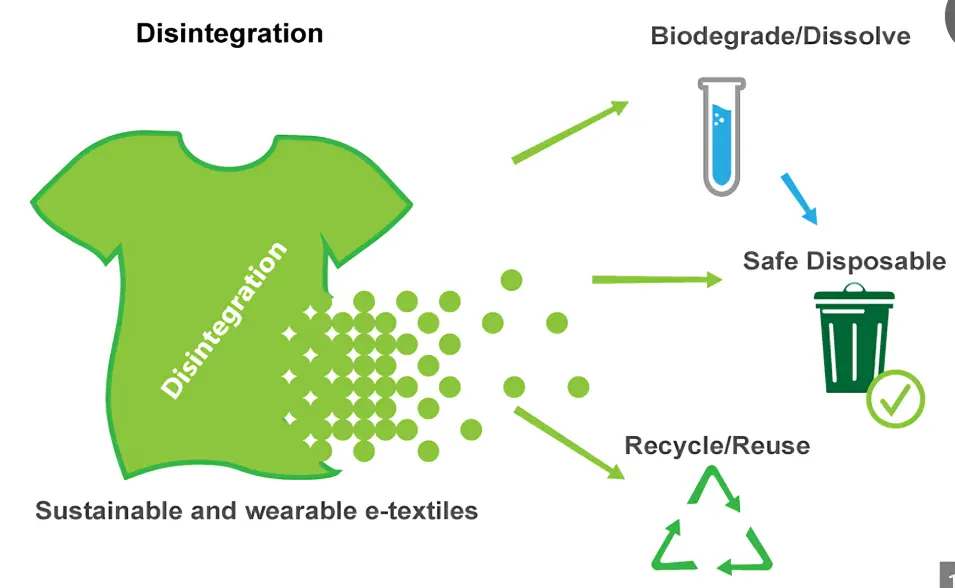Imagine stepping into a wardrobe where clothes sprout from living cells, not synthetic fibres. Where vibrant hues are painted by nature, not chemical dyes. This isn’t a scene from a futuristic film; it’s the dawn of bio-fabricated fashion, a revolutionary wave set to rewrite the future of style. In 2024, the fashion industry is experiencing a seismic shift, embracing eco-conscious innovation with the rise of bio-fabricated clothing. This groundbreaking approach seamlessly blends science, technology, and sustainability to cultivate a new fabric of fashion, one thread at a time. Ditch the conventional loom and embrace the bioreactor; bio-fabricated fashion is here to redefine style, responsibility, and the very essence of what we wear.
Key aspects of bio-fabricated fashion
#1. Biological Materials
Materials produced from living organisms, such as bacteria, fungi, and algae, are utilised in biofabricated form. By providing a sustainable substitute for conventional textiles, these materials lessen the industry’s need for commodities with high resource requirements, such as polyester and cotton.
Say goodbye to cotton fields and oil rigs! Bio-fabricated fashion is here to rewrite the script, offering an eco-friendly wardrobe spun from the magic of nature. Forget conventional textiles; imagine jackets grown from bacteria, sneakers woven from mushrooms, and vibrant colours extracted from algae. Bio-fabricated fashion utilizes nature’s finest creations:
- Bacterial cellulose: This soft, strong fabric, sculpted by friendly bacteria, can morph into clothes, shoes, and even leather-like alternatives. Imagine a kombucha jacket as soft as your morning brew!
- Fungal mycelium: The intricate root structure of mushrooms, mycelium, can be shaped and dried, forming durable, biodegradable textiles. Think sneakers woven from nature’s magic mushrooms!
- Algae: This aquatic wonder offers natural dyes and biopolymers, replacing harmful chemicals with vibrant hues from the sea. Imagine seaweed bathing your clothes in its sunshine-kissed colours!
#2. Sustainable Production Processes:
Eco-friendly methods that reduce environmental effects are used in the manufacture of biofabricated apparel. By employing renewable resources and producing fewer hazardous byproducts, bio-fabrication techniques prioritise sustainability above conventional production, which frequently results in waste and pollution. Learn more about circular fashion –What is circular fashion?
Enjoy reading this? Subscribe below for more content like this….
Bio-fabrication process
Bio-fabrication encompasses a diverse array of processes, all of which leverage biological systems such as microorganisms, plants, or animal cells to produce textiles and materials. These processes can range from fermentation of microorganisms to the cultivation of plant-based fibers. One notable example is the use of algae for bio-polymers, which not only yields versatile materials but also contributes to carbon sequestration by absorbing carbon dioxide from the atmosphere. This dual benefit underscores the potential of bio-fabrication to mitigate environmental impact while meeting the demands of the fashion industry.

Environmental Impact of Bio-fabrication process
Bio-fabrication processes can even have a positive impact on the environment. For example, algae used for bio-polymers can absorb carbon dioxide from the atmosphere, contributing to carbon sequestration. By harnessing renewable resources and minimizing the use of harmful chemicals, bio-fabricated fashion has the potential to reduce pollution and resource depletion associated with conventional textile production. Moreover, the biodegradability of many bio-based materials offers a sustainable end-of-life solution, further reducing environmental burden.
Benefits of bio-fabricated fabric
Certain bio-fabricated materials, such as bacterial cellulose, offer additional functionalities that go beyond conventional textiles. These materials exhibit natural odor resistance and UV protection, reducing the need for harmful chemical treatments. By integrating these properties into clothing and accessories, bio-fabricated fashion not only enhances wearer comfort but also promotes healthier and more sustainable products. Additionally, bio-based materials can be engineered to possess specific properties, opening up new possibilities for innovation and design in the fashion industry.
Examples of Bio-fabricated fabric:
- Bacterial Cellulose: Produced through fermentation by bacteria such as Acetobacter xylinum, bacterial cellulose offers exceptional properties such as high tensile strength and water retention. This material is cultivated in a controlled environment using renewable resources, making it a sustainable alternative to traditional cellulose-based textiles.
- Mycelium Leather: Mycelium, the root structure of fungi, can be grown into a leather-like material through a process called mycotecture. By harnessing agricultural waste such as sawdust or agricultural by-products, companies like MycoWorks produce mycelium leather with minimal environmental impact.
- Algae-based Fabrics: Algae cultivation for textile production involves harnessing the photosynthetic capabilities of algae to produce bio-polymers. Companies like Algaeing have developed techniques to extract biopolymers from algae, which can be spun into fibers or used as coatings for existing textiles.
Pioneering Companies and Closed-Loop Systems
Several companies are leading the charge in pioneering sustainable bio-fabrication practices and implementing innovative closed-loop systems.
Bolt Threads specializes in bio-engineered silk proteins derived from yeast fermentation, offering a cruelty-free alternative to silk production. Their closed-loop system involves recycling water and nutrients to minimize waste and environmental impact.
Modern Meadow, which cultivates animal-free leather through biofabrication techniques, reducing the need for livestock farming and associated environmental degradation.
Bio-fabrication allows for a high degree of customisation in clothing design. Through genetic engineering and controlled growth processes, designers can tailor garments to individual preferences, providing consumers with unique, made-to-order fashion items.
Addressing Potential Challenges
When it comes to bio-fabricated fashion, ethical considerations are paramount, particularly concerning genetically modified organisms (GMOs) and responsible sourcing of bio-materials. GMOs raise concerns about potential environmental impacts, biodiversity loss, and unintended consequences on ecosystems.
Moreover, genetic ownership opens a entire new can of worms (literally and figuratively speaking!)
Questions arise regarding ownership and control of genetic resources, as well as transparency and accountability in genetic engineering processes. Responsible sourcing of bio-materials involves ensuring fair labor practices, equitable distribution of benefits, and sustainable management of natural resources. By addressing these ethical concerns, the bio-fabricated fashion industry can uphold principles of environmental stewardship, social justice, and respect for biodiversity.
Accessibility and Affordability
While bio-fabricated fashion holds immense potential for sustainability and innovation, ensuring accessibility and affordability remains a critical challenge. Customized bio-fabrication processes often require advanced technology and expertise, leading to higher production costs. To make customized bio-fabricated fashion accessible to a wider audience, strategies such as economies of scale, technological innovation, and collaborative partnerships can help reduce costs. Moreover, initiatives to democratize access to bio-fabrication tools and knowledge, such as open-source platforms and community-based workshops, can empower individuals and small businesses to participate in the bio-fabrication revolution.
Design and User Experience
In the realm of bio-fabricated fashion, design and user experience play a crucial role in shaping the adoption and acceptance of customized products. Thoughtful design considers not only aesthetic appeal but also functionality, comfort, and sustainability. User experience encompasses the entire lifecycle of a product, from customization and ordering to wearability and end-of-life disposal. In bio-fabricated customization, user-friendliness and control over the design process are essential for fostering consumer engagement and satisfaction. By prioritizing design innovation and user-centric approaches, bio-fabricated fashion can offer personalized experiences that resonate with consumers while promoting sustainable values and practices.
Biodegradability
The biodegradability of bio-fabricated apparel is one of its most notable qualities. While bio-fabricated materials address the end-of-life concerns associated with fashion goods, traditional textiles contribute to the problem of microplastic pollution. Biofabricated materials naturally break down without affecting the environment.
Biodegradation is a natural process whereby organic materials are broken down into simpler compounds by microorganisms such as bacteria, fungi, and enzymes. In composting conditions, which provide oxygen, moisture, and appropriate temperature, microorganisms metabolize organic matter, releasing carbon dioxide, water, and biomass. Enzymes secreted by microorganisms catalyse chemical reactions that degrade complex molecules like cellulose and lignin into smaller molecules that can be assimilated by microorganisms for energy and growth. Ultimately, biodegradation results in the conversion of organic materials into humus, a nutrient-rich soil amendment.
Potential challenges of biodegradability
While biodegradability offers benefits in terms of waste reduction and resource recovery, it also raises potential concerns that must be addressed:
- Harmful Byproducts: Some biodegradation processes may produce byproducts such as methane or volatile organic compounds, which can contribute to air and water pollution. Proper composting techniques and monitoring can help mitigate these risks.
- Ecosystem Impacts:Introducing bio-fabricated materials into ecosystems may disrupt natural nutrient cycles and microbial communities, potentially affecting soil health and biodiversity. Understanding the ecological context and conducting environmental assessments can minimize adverse impacts.
By addressing these concerns through research, regulation, and responsible stewardship, bio-fabricated materials can realize their potential as sustainable alternatives to conventional textiles, supporting a circular economy and reducing environmental harm.
Collaboration with Science and Tech Industries
The fashion industry’s adoption of bio-fabricated fashion is contingent upon cooperation with the scientific and technological domains. In order to push the envelope of what is feasible, researchers and fashion designers collaborate closely, creating an interdisciplinary approach that ushers in a new phase of innovation in the sector.
As the fashion industry increasingly embraces bio-fabricated fashion, it not only meets the growing demand for sustainable alternatives but also sets a precedent for future innovations. This innovative approach aligns with global efforts to reduce the ecological footprint of the fashion industry and ushers in a new era where style and sustainability seamlessly coexist.
Citations:
- The Sustainable Fashion Forum: thesustainablefashionforum
- MDPI – Circular Fashion and Sustainability: mdp
- Vogue Business – Circular Fashion
- Ellen MacArthur Foundation – Fashion and the Circular Economy: Vogue Business – Circular Fashion
- ellenmacarthurfoundation
- Ellen MacArthur Foundation – Fashion Overview:
- ellenmacarthurfoundation
- Ellen MacArthur Foundation – Fashion and the Circular Economy
Read also


Wow, wonderful blog structure! How lengthy have you been running a blog for?
you make running a blog look easy. The total look of your
website is magnificent, as well as the content material!
Starting a fashion brand can be a thrilling journey into creativity and entrepreneurship. It’s about crafting your unique style narrative and translating it into a brand that resonates with your audience. Exciting times ahead!
Thanks for sharing. I read many of your blog posts, cool, your blog is very good.
Thanks for sharing. I read many of your blog posts, cool, your blog is very good.
What is Bio-fabricated Fashion?
Thank you for your sharing. I am worried that I lack creative ideas. It is your article that makes me full of hope. Thank you. But, I have a question, can you help me?